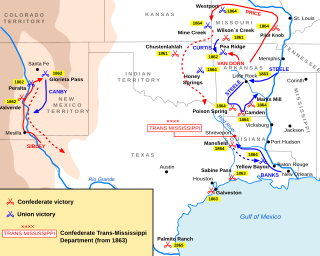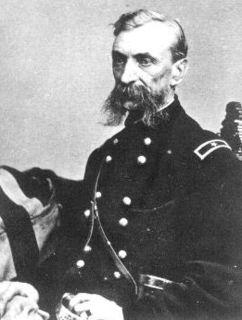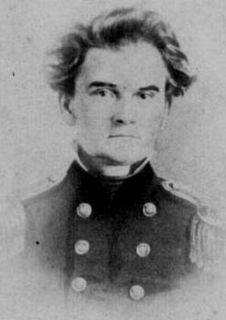Related Research Articles

The Battle of Pea Ridge, also known as the Battle of Elkhorn Tavern, took place in the American Civil War near Leetown, northeast of Fayetteville, Arkansas. Federal forces, led by Brig. Gen. Samuel R. Curtis, moved south from central Missouri, driving Confederate forces into northwestern Arkansas.

The Battle of Whitney's Lane was a small, but psychologically important, land battle of the American Civil War fought on May 19, 1862, in north-central Arkansas.

The Battle of Cotton Plant also known as Action at Hill's Plantation or Action at Cache River or Action at Round Hill was fought during the American Civil War in Woodruff County, Arkansas. Frustrated in its attempt to march to Little Rock by a lack of supplies, the Union Army of the Southwest under the command of Samuel Ryan Curtis moved south down the White River. Curtis's army encountered a Confederate force led by Albert Rust on the east bank of the Cache River near Cotton Plant. Rust was only able to bring two Texas cavalry regiments into action. These horsemen attacked the Federal advance guard under Charles Edward Hovey, but after a spirited fight, Union reinforcements arrived and drove off the Texans. Rust's force made a disorderly retreat and Curtis's army was able to march south to Clarendon before veering east to occupy Helena on the Mississippi River.

Samuel Ryan Curtis was an American military officer, and one of the first Republicans elected to Congress. He was most famous for his role as a Union Army general in the Trans-Mississippi Theater of the American Civil War, especially for his victories at the Battles of Pea Ridge in 1862 and Westport in 1864.

The Battle of Wilson's Creek, also known as the Battle of Oak Hills, was the first major battle of the Trans-Mississippi Theater of the American Civil War. It was fought on August 10, 1861, near Springfield, Missouri. Missouri was officially a neutral state, but its governor, Claiborne Fox Jackson, supported the South and secretly collaborated with Confederate troops.

The XI Corps was a corps of the Union Army during the American Civil War, best remembered for its involvement in the battles of Chancellorsville and Gettysburg in 1863.

Franz Sigel was a German American military officer, revolutionist and immigrant to the United States who was a teacher, newspaperman, politician, and served as a Union major general in the American Civil War. His ability to recruit German-speaking immigrants to the Union armies received the approval of President Abraham Lincoln, but he was strongly disliked by General-in-Chief Henry Halleck.

The Missouri State Guard (MSG) was a military force established by the Missouri General Assembly on May 11, 1861. While not a formation of the Confederate States Army, the Missouri State Guard fought alongside Confederate troops and, at various times, served under Confederate officers.

The Army of the West, also known as the Trans-Mississippi District, was a formation of the Confederate States Army during the American Civil War that was a part of the Army of Mississippi. It saw action in the Battle of Pea Ridge, Battle of Corinth, and Battle of Iuka and consisted of about 20,000 personnel.

The Trans-Mississippi Theater of the American Civil War consists of the major military operations west of the Mississippi River. The area is often thought of as excluding the states and territories bordering the Pacific Ocean, which formed the Pacific Coast Theater of the American Civil War (1861–1865).

Alexander "Sandor" Asboth was a Hungarian military leader best known for his victories as a Union general during the American Civil War. He also served as United States Ambassador to Argentina and as United States Ambassador to Uruguay.

Brigadier-General Mosby Monroe Parsons was a senior officer of the Confederate States Army who commanded infantry in the Trans-Mississippi Theater of the American Civil War. Parsons was murdered by Captain Dario Garza, at the head of a body of Mexican soldiers, on or about August 15, 1865, near China, Nuevo León, Mexico.

Eugene Asa Carr was a soldier in the United States Army and a general in the Union Army during the American Civil War. He was awarded the Medal of Honor for his actions at the Battle of Pea Ridge.

Colton Greene was an American businessman and soldier. He served as a Confederate general during the American Civil War, mostly leading cavalry units. After the war he pursued several successful civic projects and public functions in Tennessee.
Frederick Schaefer was a German revolutionary and Union Army colonel during the American Civil War. He was a brigade commander at the battles of Pea Ridge and Stones River where he was killed in action.
The Military Division of the Missouri was an administrative formation of the United States Army that functioned through the end of the American Civil War and the Indian Wars that continued after its conclusion. It was created by the War Department on February 3, 1865, at the direction of General Ulysses S. Grant to bring all the military departments west of the Mississippi River under a single commander.
The Department of the Northwest was an Army Department created September 6, 1862 by the Union Army to put down the Sioux uprising in Minnesota. It was composed of the forces within the territory of the states of Wisconsin, Minnesota and Iowa, and the Nebraska and Dakota Territories . Nebraska Territory was detached to the Department of the Missouri on Oct. 11 1862.

The Battle of Cotton Plant saw a 10,000-strong Union Army commanded by Samuel Ryan Curtis encounter a 5,000-man Confederate force led by Albert Rust. A Union advance guard commanded by Charles Edward Hovey did most of the fighting, repelling an attack by two Texas cavalry regiments led by William Henry Parsons. Union reinforcements under William P. Benton arrived and pressed the Texas cavalry and Arkansas infantry into a disorderly retreat. Curtis's army subsequently occupied Helena. Earlier in the campaign, Texas cavalry inflicted 49 casualties on a Union foraging party in the Battle of Whitney's Lane near Searcy on May 19, 1862. At the Battle of L'Anguille Ferry near Marianna on August 3, 1862 the Texas cavalry overran a Union wagon convoy.

Battery B, 1st Missouri Light Artillery Regiment, also known as Welfley's Independent Missouri Battery, was an artillery battery that served in the Union Army during the American Civil War. Organized in September 1861, Welfley's Independent Battery fought at Pea Ridge and in the White River campaign. After its name changed to Battery B, 1st Missouri in December 1862, it fought at Cape Girardeau, Chalk Bluff, Vicksburg, Sterling's Plantation, and Brownsville. In September 1864, the unit ceased to exist when it was consolidated with three other Missouri batteries while stationed at New Orleans.

The 1st Missouri Field Battery was a field artillery battery that served in the Confederate States Army during the American Civil War. As the Confederates had lost control of the state of Missouri after the Battle of Pea Ridge in early 1862, the battery was formed by Captain Westley F. Roberts in Arkansas in September as Roberts' Missouri Battery. The unit then fought in the Battle of Prairie Grove on December 7, as part of a Confederate offensive. Roberts' Battery withdrew after the battle and transferred to Little Rock, Arkansas, where Roberts resigned and was replaced by Lieutenant Samuel T. Ruffner.
